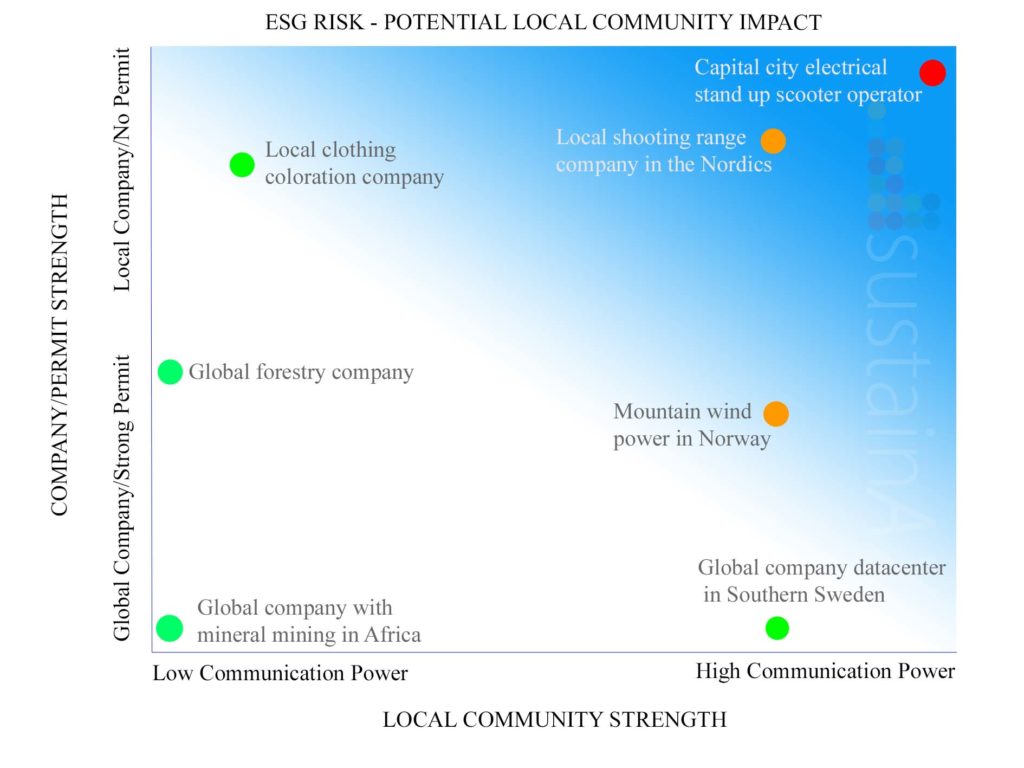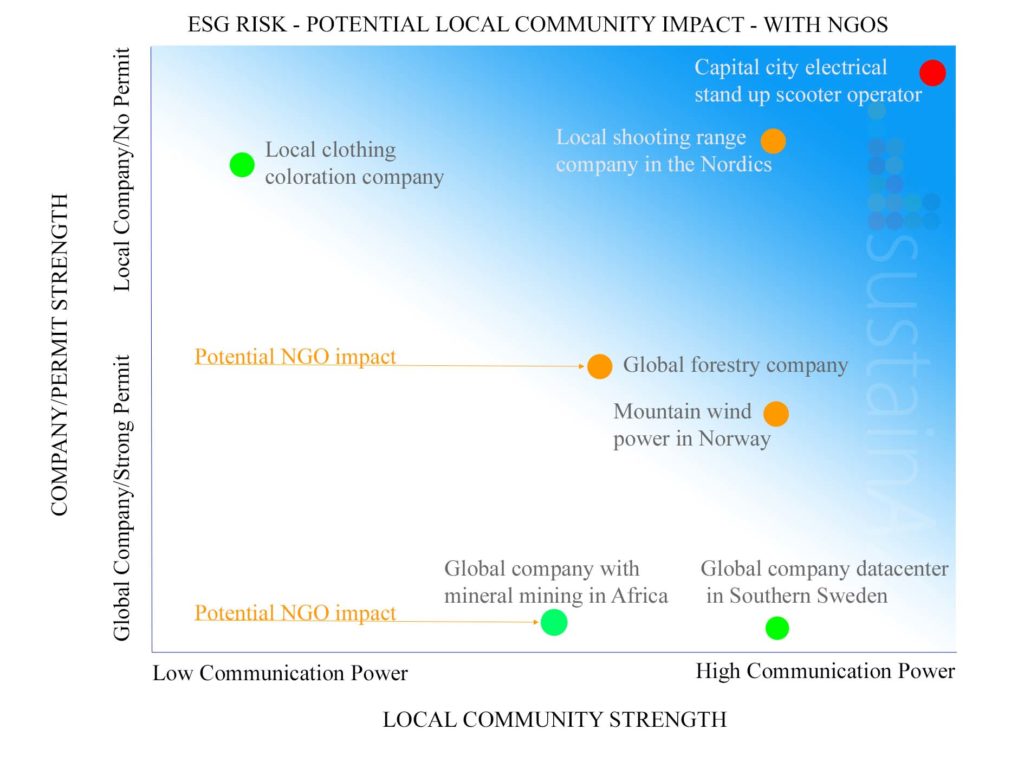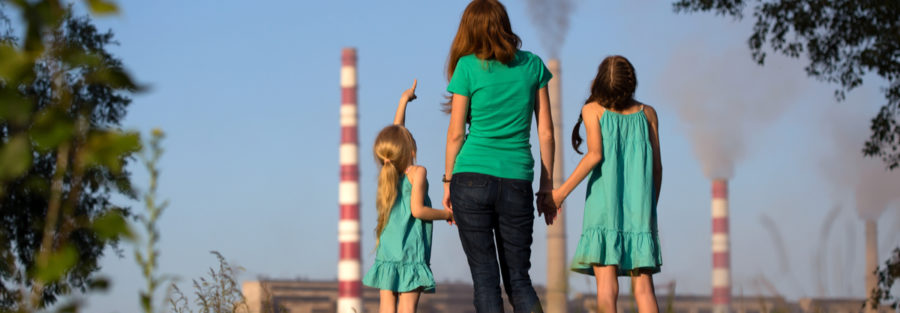How the ESG* analysts should think – Are weak local communities only a quasi-stakeholder? Unless NGOs enter the stage?
Most companies talk warmly about local communities in their CSR reporting. For many it is in reality a tick box exercise and often consist of financing local initiatives; a sort of payment to be allowed to do what is against the interest of the local community? We see little local community induced changes in projects that have been given permits to construct, if any it is cosmetic. Let’s have a look at the power game between companies and local communities and try to schematise this.
THE DIMENSIONS
Local community with communication power versus local communities without communication power
A local community with strong communication power is representing a bigger risk for the companies than a local community with weak communication power. With communication power I here mean the capability to reach out to many inside and outside the local community and make them react. The link in-between communication power, and location and richness is quite obvious. Remote and poor means low communication power and vice versa. Other elements that count are educational level, societal awareness, etc.
An example of strong communication power is local urban communities in Europe, particularly in the Northern Europe, while an example of weak communication power is communities in remote locations in emerging countries, maybe even without internet access.
Global companies with permit versus local companies without permit
These are the two extremes, nothing will stop a strong global company with a permit from a government agency to proceed, while a local company with no permit is much more exposed to the risk of the community reaction. This even though many examples of the first may have a much worse impact on local communities. Other elements that count here are, strength of the company, strength of the permit, level of business ethics, etc.
The first example can be a global company with permits to build a new chemical plant requiring state permits and the other can be a smaller local company with a noisy or smelly permit free activity.
THE EXTREMES
Do strong companies with a permit have to care about the local communities’ opinions?
Combining the two areas above, some extreme cases can be put together: a) poor and remote local communities with low communication power vs global companies with strong permit and b) rich and urban local communities with high communication power vs local companies without permit
An example of the first can be a global company mining with a permit for minerals in Africa and the second a stand up electrical scooter company in a Nordic capital.
DIFFERENCIATING FACTORS
The permit to construct is not as fragile as the permit to operate
This is particularly true if all the potential damage is done during construction and if the damage during operation is debated and not obvious.
A good example here is onshore wind power farms in mountains as their construction will for some members of the local communities destroy for ever the mountain view, while the operation in itself does not make the view worser for these community members. Also once constructed, there is nothing the local community can do about it, as there are no new arguments to bring to the table. The risk is close to taken off the table. This is very different to a plant emitting regular pollution to the air or noise with a permit. Here the potential risk of losing the permit to operate is constant.
In Figure 1, we try to show some examples of different relationships as mentioned as examples hereover. The darker the blue background, the more power to the local community.
Figure 1 – Communication Power vs. Company Power/Permit Strength

Source: sustainAX, September 2021. In the graphs, the green dot signifies low probability of impact on business from local communities, orange middle risk and the red high risk.
NGOs are balancing the game
Many NGOs provide strong support to local communities, and they play a particularly important role for poor local communities with weak communication power as they are characterised by strong communication power and for many of them global reach. Notice in the graph below with the same examples as in Figure 1, how the ESG risks stemming from local communities can increase with the involvement of the NGOs.
Figure 2 – Communication Power vs Company Power/Permit Strength with the NGO effect

Source: sustainAX, September 2021. In the graphs, the green dot signifies low probability of impact on business from local communities, orange middle risk and the red high risk.
NGOs’ global role
There are many “no-man’s-lands” on the earth, far out on the sea, in the deep remote forests, in remote tundra, the South Pole, deep seabed… Here there may not be any local communities that can raise their voice against a potentially detrimental project. Here the NGOs can take on a role to defend the “global” local community.
Some examples here are sea bottom trawling, deforestation and seabed mining.
THE CONCLUSION
Local community ESG risk
As ESG analysts, we work on the risk analysis all the way to the ESG Risk Integration, where we estimate how the ESG risks impact a company’s P&L, balance sheet and other risk metrics like required risk premium or for bonds credit rating. Among many factors, we also look at how risks can play out for the company in question due to local community issues. Is there a risk of loss of license to operate? Can assets be written down? Will they take higher costs than expected? Risk of sabotage? Reputational risk?
After having ESG researched a lot of companies, we see that a comparable situation with local communities does not mean the same risk for different companies. As discussed above, a weak local community (weak communication power) have little to say while a strong local community’s voice can be heard. But this again depend on the strength of the company and their license, and here the licence to build often represents a tool to ignore local communities. It can be made looking good though by investing in local initiatives. The latter are initiatives that in some examples can be classified to buy positive voices or peace. It can also split the local community, making their voices even weaker.
Remains the reputational risk for strong companies not caring about local communities, but this is in reality a risk mainly for companies having consumer clients as these can punish a company severely after a Facebook story going viral. The further away a company is from the consumer, the less risk they have of potential damage stemming from reputational risk.
Therefore, in ESG Integration, when there is a weak local community and a strong company with a strong licence, the real ESG risk stemming from local communities is in reality rather small. This is particularly true for companies with a place in the value chain far away from consumer power.
Examples here are global companies in the upstream business, close to resources and in industrial and chemical processing, typically companies the consumer never hear about.
THE FUTURE
What can change this?
The increasing focus on the supply chain in sustainability and ESG research will increase focus on this issue and the possibility to hide away will diminish.
This is driven by legislation and regulation with Environmental and Social aspects and by investors requiring more visibility on the investee companies’ supply chain.




